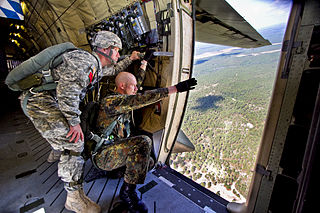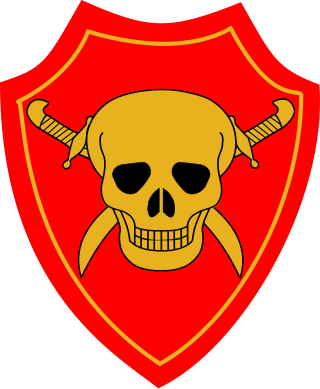A paratrooper helmet is a type of combat helmet used by paratroopers and airborne forces. The main difference from standard combat helmets is that paratrooper helmets have a different harness and lining to withstand impact when jumping from aircraft and to keep the helmet stable in flight, and most have a lower-profile shell to reduce wind resistance. Most modern combat helmets have features making them suitable for airborne use.

A paratrooper is a military parachutist—someone trained to parachute into a military operation, and usually functioning as part of an airborne forces. Military parachutists (troops) and parachutes were first used on a large scale during World War II for troop distribution and transportation. Paratroopers are often used in surprise attacks, to seize strategic objectives such as airfields or bridges.

Airborne forces are ground combat units carried by aircraft and airdropped into battle zones, typically by parachute drop or air assault. Parachute-qualified infantry and support personnel serving in airborne units are also known as paratroopers.

The 101st Airborne Division (Air Assault) ("Screaming Eagles") is a light infantry division of the United States Army that specializes in air assault operations. It can plan, coordinate, and execute multiple battalion-size air assault operations to seize terrain. These operations can be conducted by mobile teams covering large distances, fighting behind enemy lines, and working in austere environments with limited or degraded infrastructure. Its unique battlefield mobility and high level of training have kept it in the vanguard of U.S. land combat forces in recent conflicts: for example, foreign internal defense and counterterrorism operations in Iraq, in Afghanistan in 2015–2016, and in Syria, as part of Operation Inherent Resolve in 2018–2021.

The Russian Airborne Forces are the airborne forces branch of the Russian Armed Forces. It was formed in 1992 from units of the Soviet Airborne Forces that came under Russian control following the dissolution of the Soviet Union.

The Parachutist Badge, also commonly referred to as "Jump Wings" is a military badge of the United States Armed Forces. Some services, such as the Marine Corps, officially refer to it as an insignia instead of a badge. The United States Space Force and United States Coast Guard are the only branches that do not award the Parachutist Badge, but their members are authorized to receive the Parachutist Badges of other services in accordance with their prescribed requirements. The DoD military services are all awarded the same Military Parachutist Badge. The U.S. Army and U.S. Air Force issue the same Senior and Master Parachutist Badges while the U.S. Navy and U.S. Marine Corps issue the Navy and Marine Corps Parachutist Insignia to advanced parachutists. The majority of the services earn their Military Parachutist Badge through the U.S. Army Airborne School.

The Modular Integrated Communications Helmet (MICH) is a U.S. combat helmet and one of several used by the U.S. military. It was developed by the United States Army Soldier Systems Center to be the next generation of protective combat helmets for use by the U.S. Army.

The 1st Airborne Brigade, also known as the Narashino Airborne Brigade, is stationed in the Japan Ground Self-Defense Force (JGSDF) Camp Narashino in Funabashi, Chiba Prefecture.

The Denison smock was a coverall jacket issued to Special Operations Executive (SOE) agents, the Parachute Regiment, the Glider Pilot Regiment, Air Landing Regiments, Air Observation Post Squadrons, Commando units, and other Commonwealth airborne units, to wear over their Battle Dress uniform during the Second World War. The garment was also issued as standard to the scout and sniper platoons of line infantry battalions.

The Advanced Combat Helmet (ACH) is the United States Army's current combat helmet, used since the early 2000s. It was developed by the United States Army Soldier Systems Center, the U.S. Army Special Operations Command, and the U.S. Army Research Laboratory to be the next generation of protective combat helmets for use by the American ground forces. The ACH is derived from the Modular Integrated Communications Helmet.

The Mk 6 helmet is a type of combat helmet that was the standard of the British Armed Forces as well as another supplied helmet of the UN during peacekeeping operations. The Mk 6 replaced the Mk IV helmet in army service and the RAC helmet in naval service. The jump in MK numbers is thought due to the confusion surrounding the MK IV helmet using the MK V lining, introduced in 1959.

The maroon beret in a military configuration has been an international symbol of airborne forces since the Second World War. It was first officially introduced by the British Army in 1942, at the direction of Major-General Frederick "Boy" Browning, commander of the British 1st Airborne Division. It was first worn by the Parachute Regiment in action in North Africa during November 1942.

Jumpmasters are the expert paratroopers in an airborne unit who train and teach the military techniques for jumping from airplanes. They are responsible for training soldiers who enter Army Airborne School into paratroopers and managing airborne jump operations in airborne units across all branches of services.
The 40. Fallschirmjägerbataillon Willi Sänger was the only airborne infantry formation of the National People's Army, formed in 1962. The battalion was based in Prora on Rügen island (1962–82) and later near Potsdam (1982–90). Numerous military observers had considered the unit to be one of the most professional forces in the Warsaw Pact despite its small size.

The Ukrainian Air Assault Forces, known until 2017 as the Ukrainian Airmobile Forces, are the airborne forces of Ukraine. They formed in 1992 and were part of the Ukrainian Ground Forces until 2016, when they separated to become one of five branches of the Armed Forces of Ukraine. The Air Assault Forces are in constant combat readiness and are the high-mobility branch of the military, responsible for air assaults and military parachuting operations. Before the Russo-Ukrainian War they were also the main forces sent by Ukraine to peacekeeping missions around the world. They are considered the elite of Ukraine's armed forces.

The 82nd Airborne Division Sustainment Brigade is a sustainment brigade of the United States Army based at Fort Liberty, North Carolina. It provides logistical support to and is part of 82nd Airborne Division.

The CG634 is the Canadian Armed Forces' main combat helmet. It was introduced in 1997 and is based on the French Gallet TC-3 helmet. The helmet has protection equal to an NIJ Level 3a rating, being able to stop a shot from a .357 Magnum.

The Defense Companies were an all-Alawite paramilitary force in Syria that were commanded by Rifaat al-Assad. Their task was to defend the Assad government, and Damascus, from internal and external attack. In 1984 the 55,000 strong Defense Companies was broken up and merged into the Syrian Arab Army as the Republican Guard, and the 14th Special Forces Division, comprising 5 Special Forces regiments. The rump force then became the 569th Armored Division, which years later became the 4th Armoured division

The Enhanced Combat Helmet (ECH) is a combat helmet designed in conjunction of a joint program of the United States Marine Corps and United States Army to replace the current combat helmets in use by the U.S. Army, Air Force, Navy, and Marines. Although similar in shape of the Advanced Combat Helmet and its predecessor the Modular Integrated Communications Helmet, the ECH instead is constructed using thermoplastics instead of the ballistic fibers used on the previous generation combat helmets.
The OR-201, also designated Kasda OR-201 Model 76 or M-76 for short, is a combat helmet of Israeli origin. Developed in the 1970s, the OR-201 was one of the world's first ballistic helmets. It was subsequently exported on a large scale and has been used by many militaries worldwide.
The M76 Paratrooper helmet is a combat helmet of British origin issued to paratroopers and airborne forces of the British Army.
{{cite web}}: CS1 maint: archived copy as title (link)